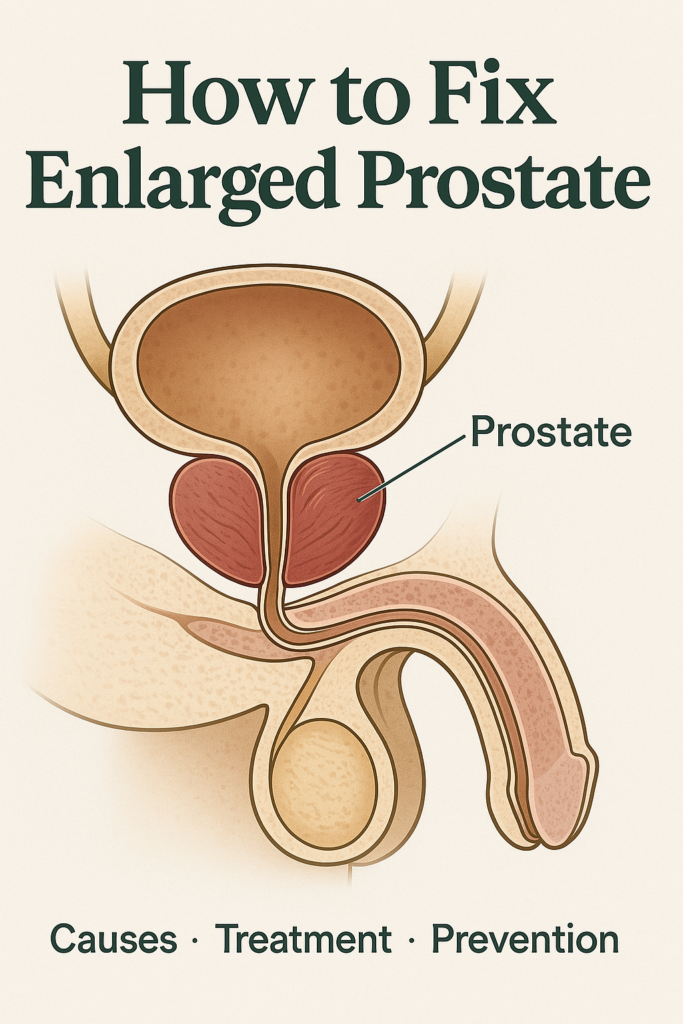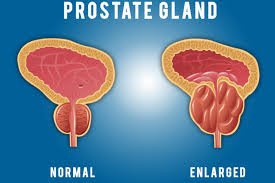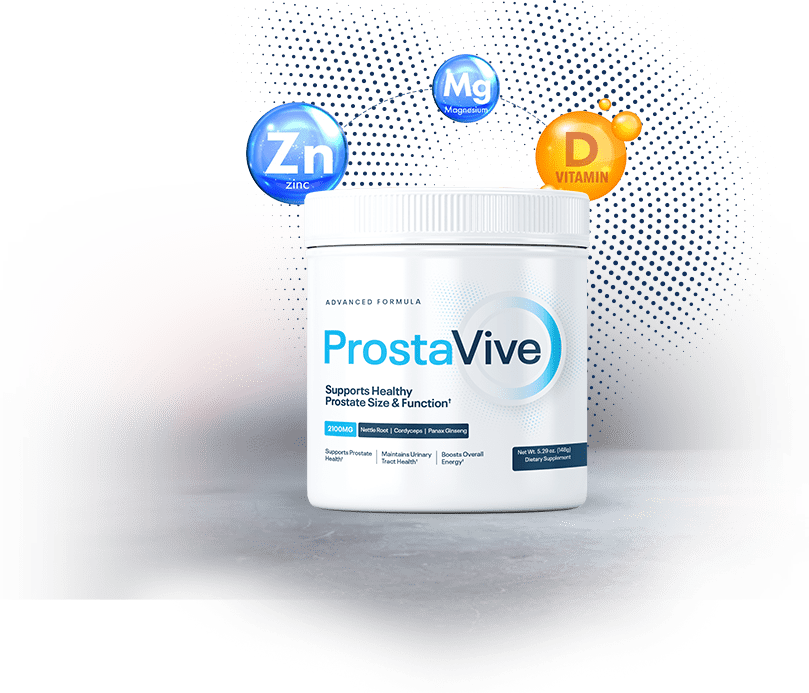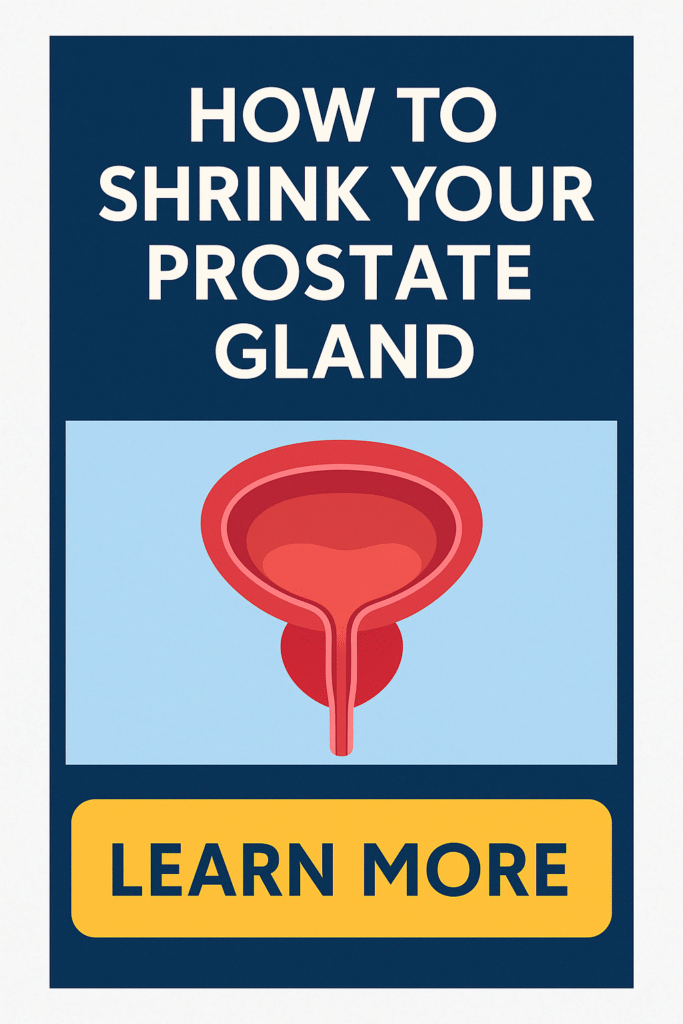How To Shrink Prostate Gland Naturally

How To Shrink Prostate Gland Naturally: For many men entering their middle years, the discomfort and inconvenience of benign prostatic hyperplasia (BPH) become an all too familiar struggle. This non-cancerous enlargement of the prostate gland can lead to bothersome urinary symptoms that interfere with daily life. While medical treatments are available, many seek how to shrink the prostate gland naturally, longing for solutions that align with holistic health.
This quest for a natural approach stems from a growing awareness of the benefits associated with lifestyle adjustments, dietary plans, and the use of time-tested herbal remedies. Understanding the impacts of foods like soy and green tea, and harnessing the power of herbs such as saw palmetto, offers a promising avenue for those looking to manage BPH symptoms proactively. By examining these alternatives, men can find personalized strategies that cater to their unique health profiles.
In this article, we delve into the intricacies of shrinking the prostate naturally. We will explore a range of lifestyle changes, dietary strategies, effective herbal treatments, and supportive supplements. Through informed choices, you can mitigate the effects of BPH and reclaim comfort and ease in your daily routine.
Understanding Benign Prostatic Hyperplasia (BPH)
How To Shrink Prostate Gland Naturally: Benign Prostatic Hyperplasia (BPH) is an age-related condition characterized by the non-cancerous enlargement of the prostate gland. As men age, hormonal changes trigger prostate growth, which can lead to an increased number of prostate cells. This growth often results in symptoms such as frequent urination, difficulty starting urine flow, and disrupted sleep due to nocturia.
BPH is common in aging men, affecting nearly half of men over 50 and up to 90% in their 80s. This widespread prevalence can be attributed to the naturally occurring changes in testosterone levels and the conversion of testosterone to dihydrotestosterone (DHT) within the prostate tissues.
The impact of BPH on daily life can be significant, contributing to urinary tract symptoms and decreasing quality of life. Many men seek how to shrink prostate gland naturally, aiming to avoid the side effects of medical treatments or surgical procedures. Natural solutions focus on lifestyle adjustments, dietary changes, and the use of herbal remedies such as pumpkin seeds and omega-3 fatty acids, offering hope to those who wish to manage this condition without invasive interventions.
| Symptoms of BPH | Effects on Daily Life |
|---|---|
| Frequent urination | Sleep disruption |
| Difficulty starting urination | Reduced work efficiency |
| Weak urine flow | Social embarrassment |
Signs and Symptoms of BPH

How To Shrink Prostate Gland Naturally: Understanding the signs and symptoms of Benign Prostatic Hyperplasia (BPH) is essential for early identification and management of the condition through natural methods. Men often experience a range of urinary symptoms as their prostate gland enlarges. Here are some common symptoms to look out for:
- Frequent Urination: An increased need to urinate, particularly noticeable during the night, known as nocturia.
- Weak Urine Stream: A noticeable reduction in the strength and volume of urine flow, which can make it difficult to fully empty the bladder.
- Nocturia: The frequent need to urinate at night, which disrupts sleep and diminishes quality of life.
- Urgency: A sudden, strong urge to urinate that can be difficult to control.
- Incomplete Emptying: A sensation that the bladder is not completely emptied after urination.
Early detection of these symptoms is crucial in managing BPH naturally. By noticing the signs early, individuals can explore a variety of lifestyle changes and natural remedies that may help alleviate these issues, improving urinary health and overall comfort. Identifying these symptoms promptly allows for effective management strategies, lessening the impact on daily life.
Herbal Remedies for Prostate Health
How To Shrink Prostate Gland Naturally: For those searching for natural methods to shrink the prostate gland, herbal remedies offer a promising avenue. Research has shown that specific herbs can target the root causes of an enlarged prostate, such as hormonal imbalances and inflammation. By complementing these powerful herbal strategies with supplements like ProstaVive, which is known for its prostate-supporting blend, men can achieve enhanced results. This section delves into some of the most effective herbal options available. Together, these herbs and supplements form a formidable natural arsenal against prostate issues, promoting prostate health and improving quality of life by potentially alleviating symptoms such as frequent urination and poor urine flow.
Saw Palmetto
Saw Palmetto is one of the most popular herbs for managing prostate health. This small, palm-like plant is widely recognized for its ability to inhibit the conversion of testosterone to dihydrotestosterone (DHT), a hormone that contributes to prostate enlargement. By reducing DHT levels, Saw Palmetto helps to manage the size of the prostate gland, making it a valuable natural treatment option. Saw Palmetto is often included in supplements such as ProstaVive, making it easy to incorporate into a daily regimen for those aiming to support their prostate health naturally.
Stinging Nettle
Stinging Nettle is another herbal remedy well-regarded for its benefits to urinary health and prostate well-being. This herb effectively reduces inflammation, which is a crucial factor in managing symptoms of an enlarged prostate. By decreasing inflammation, Stinging Nettle can help to alleviate urinary tract symptoms, improving the flow of urine and reducing frequency and urgency issues. It supports the entire urinary system, making it a key player in natural prostate health strategies. When combined with a comprehensive supplement like ProstaVive, it may offer synergistic effects.
Pygeum
Pygeum, derived from the bark of the African cherry tree, is celebrated for its anti-inflammatory properties, making it an excellent choice for promoting prostate health. Its ability to reduce inflammation makes Pygeum an effective option for improving urinary flow and reducing the discomfort associated with prostatic hyperplasia. By supporting the reduction of prostate size, Pygeum aids in easing urinary symptoms, enhancing overall prostate functionality. The use of Pygeum, especially alongside targeted supplements like ProstaVive, forms part of a natural and effective strategy against the troubling symptoms of an enlarged prostate.
Support Your Herbal Routine with Daily Supplementation
Enhance the effects of Saw Palmetto, Stinging Nettle, and Pygeum by adding a powerful daily supplement to your routine. ProstaVive offers a complete blend that works hand-in-hand with these herbs for optimal prostate support.
Dietary Recommendations for Prostate Health

How To Shrink Prostate Gland Naturally: The connection between diet and prostate health is increasingly being explored, as dietary changes can naturally contribute to reducing an enlarged prostate, also known as benign prostatic hyperplasia (BPH). Adopting a diet rich in specific nutrients and foods can assist in shrinking the prostate and alleviating urinary symptoms. Incorporating foods that are high in antioxidants, healthy fats, and certain phytochemicals can bolster prostate health and improve the quality of life for those struggling with prostatic hyperplasia. Alongside herbal remedies, nutrition plays a crucial role in managing prostate issues and maintaining overall wellness. In this section, we explore key dietary components that offer potential benefits for the prostate gland.
Soy Products
Soy products are increasingly recognized for their role in hormone regulation, which is vital for prostate health. These products contain phytoestrogens, compounds similar to estrogen, which can help balance hormone levels and reduce the production of dihydrotestosterone (DHT), a hormone linked with prostate growth. Regular consumption of soy products such as tofu, soy milk, and tempeh can support the prostate by mitigating the effects of androgens, potentially leading to a reduction in prostate size and alleviating symptoms of BPH.
Green Tea
Known for its potent antioxidant properties, green tea is beneficial for reducing inflammation within the prostate. The antioxidants, particularly catechins found in green tea, help protect the prostate cells from damage and may slow the progression of prostate enlargement. By incorporating green tea into the daily diet, individuals can help manage inflammation and reduce the severity of urinary tract symptoms, keeping prostate health in check and supporting overall wellness.
Omega-3 Fatty Acids
Omega-3 fatty acids play a crucial role in reducing inflammation and supporting hormonal balance, which is essential for maintaining prostate health. These healthy fats, found abundantly in fatty fish like salmon, walnuts, and flaxseeds, can help decrease inflammatory responses in the body and support a healthy balance of hormones. Regular consumption of omega-3 fatty acids can contribute to shrinking the prostate gland naturally, as they dampen inflammation and potentially improve the flow of urine, alleviating some of the distressing symptoms associated with an enlarged prostate.
Lifestyle Adjustments
How To Shrink Prostate Gland Naturally: As men age, maintaining optimal prostate health becomes increasingly important, and the good news is that certain lifestyle habits can significantly influence the size and health of the prostate gland. Implementing lifestyle adjustments is a proactive approach to naturally managing an enlarged prostate and enhancing overall well-being. The focus here is adopting consistent exercise regimes and managing weight effectively, both of which play pivotal roles in shrinking the prostate gland naturally. By integrating these changes, men can potentially reduce urinary symptoms and improve their quality of life without turning to surgical procedures or medical treatments.
Importance of Regular Exercise
Regular exercise is a cornerstone of maintaining a healthy prostate. Aerobic exercises such as walking, swimming, or cycling boost cardiovascular health and encourage efficient blood circulation, which is vital for prostate health. Additionally, pelvic floor exercises, often known as Kegel exercises, specifically target the muscles around the prostate and bladder. These exercises enhance bladder control, thereby reducing urinary symptoms and aiding in the natural shrinking of the prostate. Making aerobic and pelvic floor exercises part of your routine can significantly improve prostate health and combat prostate growth.
Weight Management Strategies
Managing weight effectively, particularly around the abdomen, can have profound effects on prostate health. Abdominal fat is known to increase estrogen levels, which can contribute to prostate enlargement and disrupt hormonal balances. By reducing abdominal fat through a combination of a healthy diet and regular exercise, men can lower estrogen levels and help stabilize hormones. This hormonal balance is crucial in preventing excessive prostate growth and alleviating symptoms associated with prostatic hyperplasia. Focusing on weight management not only promotes a healthier prostate but also enhances overall health and well-being.
Consulting Healthcare Providers

How To Shrink Prostate Gland Naturally: Navigating the complexities of prostatic hyperplasia can be challenging, especially when considering natural solutions to manage symptoms. While many men hope to shrink the prostate gland naturally, it remains crucial to consult healthcare providers as the first line of action. Discussing your symptoms and treatment options with a doctor ensures a safe, personalized approach to managing prostate health. This conversation can prevent complications and tailor a plan that meets your quality of life goals. If you’re considering supplements like ProstaVive, expert advice is vital to ensure they complement rather than conflict with other treatments. Your doctor can provide insights on how dietary changes and herbal remedies might benefit you and how they fit within a comprehensive care strategy. Having a proactive dialogue with a trusted medical professional ensures that any natural methods you adopt are safe and effective.
Balancing Natural Remedies with Medical Interventions
Natural remedies can play a supportive role in managing prostate health and alleviating urinary symptoms. When overseen by a healthcare provider, these strategies can complement prescribed treatments effectively. Vitamins, dietary changes, and herbal supplements can harmoniously work alongside conventional medical interventions like 5-Alpha Reductase Inhibitors. Your doctor can help determine the most suitable blend of natural and medical approaches for improving urinary flow and reducing prostate growth.
When to Seek Professional Medical Advice
Recognizing when to seek urgent medical advice is crucial for those managing prostate symptoms. If you experience alarming signs such as blood in your urine or an inability to urinate, it’s essential to contact a healthcare professional immediately. Ignoring these symptoms can lead to complications such as urinary tract infections or severe urinary retention. An urgent medical evaluation is necessary to prevent these conditions from worsening, ensuring you receive timely and effective treatment.
Ready to Talk With Your Doctor?
Natural solutions work best when backed by expert guidance. If you’re considering supplements, explore how ProstaVive fits into your personalized care plan.
Holistic Approaches for Prostate Wellness

How To Shrink Prostate Gland Naturally: Holistic wellness goes beyond addressing just the symptoms; it embraces a comprehensive approach to health, considering the body, mind, and spirit. For men experiencing challenges with an enlarged prostate or benign prostatic hyperplasia (BPH), incorporating holistic practices can provide relief and enhance overall prostate wellness. Methods such as yoga, stress reduction, and sufficient sleep are pivotal. By integrating these practices into daily life, men can potentially improve their prostate health naturally, leading to better quality of life and reduced urinary symptoms. These approaches don’t just aim to shrink the prostate gland but also support the body’s natural healing processes. In the following sections, we will delve into specific practices that can contribute significantly to maintaining a healthy prostate and reducing the discomforts associated with prostate enlargement.
Benefits of Yoga
Yoga, a practice deeply rooted in promoting physical and mental well-being, can be particularly beneficial for prostate health. Certain yoga poses boost circulation throughout the body, potentially enhancing blood flow to the prostate and aiding in nutrient absorption. Moreover, yoga is well-known for its stress-reducing properties. Stress is a contributing factor that can aggravate the symptoms of BPH, so practicing yoga regularly may help alleviate these symptoms by promoting relaxation and reducing anxiety. Incorporating yoga into your routine could be a proactive step in managing prostate health naturally.
Mind-Body Practices
Mind-body practices such as mindfulness, meditation, and deep breathing exercises can play a crucial role in maintaining prostate health. Mindfulness encourages living in the present moment and can help reduce stress, which is often linked to worsening prostate symptoms. Meditation offers a respite from the daily grind, fostering mental clarity and reducing stress-induced cortisol levels. Deep breathing exercises can also enhance oxygen circulation and induce a calming effect on the mind and body. By engaging in these practices, men can support their mental health, which in turn may positively impact their overall prostate wellness, lowering the risk of complications and improving urinary tract symptoms.
Experience the ProstaVive Difference
Thousands of men have already discovered the natural path to better prostate health. With key ingredients like Beta-Sitosterol, ProstaVive helps you reduce symptoms, restore comfort, and reclaim your confidence—naturally.
Take the next step in your wellness journey today.
Natural Supplement Support: Enhance Your Results

How To Shrink Prostate Gland Naturally: Incorporating natural supplements into your lifestyle approach can significantly boost the effectiveness of managing prostate health. By supporting hormone balance, reducing inflammation in the prostate gland, and enhancing urinary flow, these supplements can serve as powerful allies in your wellness journey. One standout option is ProstaVive, a popular choice for many striving to maintain optimal prostate health. This supplement contains Beta-Sitosterol, an ingredient renowned for its efficacy in reducing enlarged prostate symptoms. When combined with dietary strategies, lifestyle changes, and herbal remedies, ProstaVive can deliver enhanced results, allowing you to better address issues related to prostate enlargement, such as urinary symptoms and frequent urination. By adopting this holistic approach, you position yourself for improved prostate health and overall quality of life.
Why ProstaVive Could Be the Missing Link

What sets ProstaVive apart is its carefully formulated blend of ingredients designed to support prostate health effectively. The supplement is packed with Beta-Sitosterol, known for minimizing symptoms such as urgency and frequent urination, making it a trustworthy companion in combating urinary issues. Additionally, ProstaVive’s ease of integration into daily routines makes it a convenient choice for busy individuals looking to enhance their prostate health without any added hassle. By targeting inflammation and promoting a healthy flow of urine, ProstaVive could be the missing link in your natural health regimen. To explore how ProstaVive can seamlessly support your prostate health goals, consider taking the next step toward lasting comfort and confidence. Your journey to better prostate wellness can start today—with a natural solution designed to work in harmony with your lifestyle.
Ready to Take Control of Your Prostate Health?
ProstaVive combines science-backed ingredients like Beta-Sitosterol to help reduce prostate discomfort, support better flow, and improve your quality of life—naturally.
Join thousands of men taking action toward a healthier, more confident future. Your path to relief starts here.
Conclusion and Final Thoughts

How To Shrink Prostate Gland Naturally: Overcoming the struggles of an enlarged prostate is a journey many men face, but natural solutions are within reach. By embracing lifestyle changes and dietary strategies, men can improve prostate health effectively. Consuming omega-3 fatty acids and pumpkin seeds has proven beneficial. Additionally, herbal remedies such as saw palmetto and stinging nettle can support a reduction in prostate growth and alleviate symptoms.
The importance of regular exercise and maintaining a healthy weight cannot be overstated, as they improve the flow of urine and reduce urinary symptoms. Supplements like 5-Alpha Reductase Inhibitors can also be part of the strategy to naturally shrink the prostate gland and enhance urinary tract health.
For a comprehensive approach, consider exploring natural supplements like ProstaVive, which supports prostate health and offers a gentle solution without significant side effects.
Starting your natural journey today can lead to improved quality of life and greater confidence. Take control of your prostate health by exploring these options. To further enhance your understanding and explore potential solutions, consider learning more or trying a natural supplement to support your prostate health effectively.
Ready to Take Control of Your Prostate Health?
ProstaVive combines science-backed ingredients like Beta-Sitosterol to help reduce prostate discomfort, support better flow, and improve your quality of life—naturally.
Join thousands of men taking action toward a healthier, more confident future. Your path to relief starts here.











